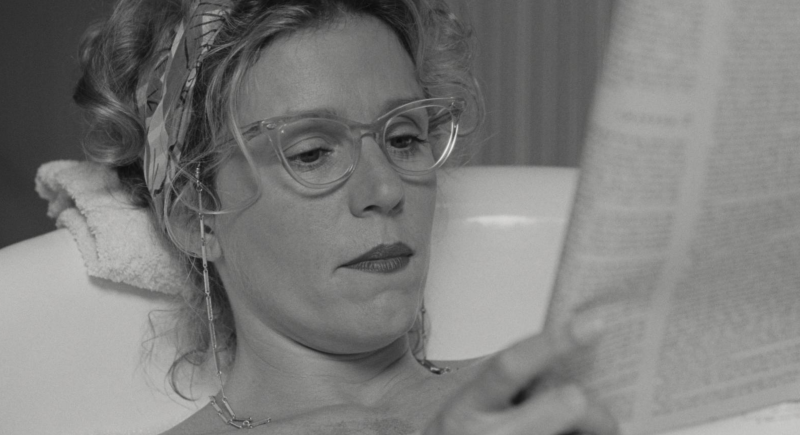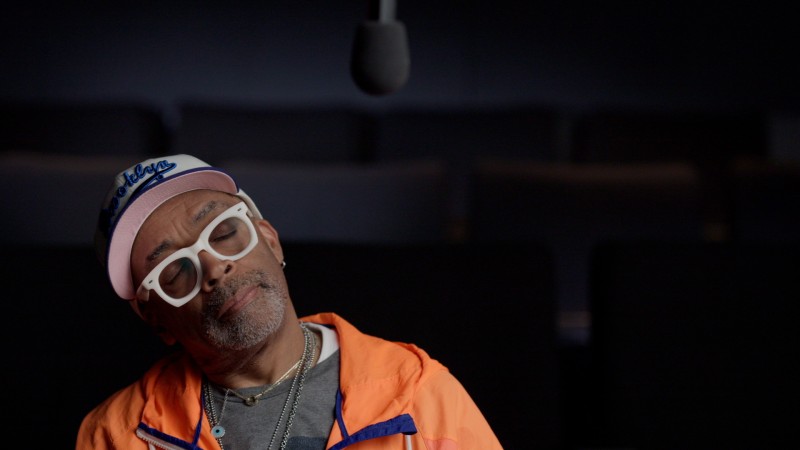Remembering Chantal Akerman: A Dry and Moving Intensity

Last Saturday, March 19, the Walter Reade Theater hosted Chantal Akerman: New York Remembers, a memorial for the late filmmaker, in the same space where, stunned by the terrible news of her death, many of us had watched the premiere of No Home Movie last October. Last weekend’s event, sponsored by City College of New York and organized by filmmaker Andrea Weiss—who in 2011 brought Akerman to teach at the school’s MFA film program—was a celebration of this beloved filmmaker’s spirit.
Force and vulnerability, generosity and humor: these were repeated refrains during the tribute. The lineup included long-time friend Marilyn Watelet, the cofounder of Paradise Films, with whom, as a teenager, Akerman watched Pierrot le fou for the first time; witnesses and facilitators of Akerman’s formative New York experience, such as Anthology Film Archives founder Jonas Mekas and Babette Mangolte, her genius cinematographer; curator Lynne Cooke, who spoke of her entry into the art world; students of hers from City College; and the filmmaker Andrew Bujalski, who was guided by her during her one-year stint at Harvard in the late 1990s. There were film and performance tributes from long-time artist friends: Vivian Ostrovsky’s short film But Elsewhere Is Always Better; a saxophone performance by Roy Nathanson, one of her actors from Histoires d’Amérique. And Henry Bean, a close American friend who helped with some of her scripts, spoke lovingly of Chantal’s irrepressible force.

The tribute ended with a reading by Chantal’s sister, Sylviane Akerman, and Weiss of rabbi Delphine Horvilleur’s eulogy. The memorial closed with Sonia Wieder-Atherton’s haunting cello playing. Wieder-Atherton was Chantal’s life partner and a major influence on Akerman’s growing incorporation of musical scores in her work. The event was bookended with projections of two excerpts from Akerman’s work: the opening shot of Histoires d’Amérique, where over a tremulous New York skyline approached by boat, Akerman’s raspy, recognizable voice narrates a tale about the transmission of Jewish traditions and remembrance, and then, concluding the event, the scene from The Eighties of an ebullient Akerman energetically conducting Magali Noël singing a song she cowrote with Marc Hérouet.
New York City will celebrate Akerman this month and throughout the month of April. Film Forum will premiere I Don't Belong Anywhere, a documentary on the filmmaker, and has scheduled a weeklong run of Jeanne Dielman, 23, quai du Commerce, 1080 Bruxelles. And BAM has scheduled a wonderful monthlong retrospective of her films, starting with her last, No Home Movie. Around the country and world the uniqueness of her oeuvre has and will continue to be celebrated in events and publications. Film Quarterly, for one, is preparing a dossier on Akerman—coedited by journal editor B. Ruby Rich and myself—for its fall 2016 issue.
I was very fortunate to have met Chantal Akerman, an artist and person of immense integrity and grace. After all these years of involvement with her work, I can still remember the experience of watching Jeanne Dielman for the first time at New York’s erstwhile Metro Theater (in an impossible double bill with Céline and Julie Go Boating). The film has never left me, and the same goes for the artist. Below is a slightly expanded version of the tribute I gave to her.
***
We had come to expect Chantal Akerman’s periodic gifts of small and large cinematic gems. Certain of this flow, we were devastated when, all too abruptly, we were forced to think of her latest film, so beautiful, as her last.
No Home Movie (2015) speaks of exile, the existential Jewish condition that propelled Chantal and her films’ wanderings. It also declares its significance as being more than a record of family gatherings. Moved by the greatest rupture, the one motivating the storyteller, edited from hours of rushes Akerman kept in her computer, the film, it becomes clear, was a way of keeping company with her aging mother. And yet this is a full-fledged Akerman film, perfectly shaped by its halting, empty spaces. Always elegant, Nelly from time to time slowly crosses the living room, the kitchen, in a film punctuated by corridors, corners, and talks that are always anxiously reassuring. One woman reminds the other to take medications, to eat, and they mother each other by trading stories long known and retold. We also watch a long Skype conversation between the two, filmed, as Chantal explains, to prove that there is no distance in the world. But hélas, there is. And the extreme melancholy of the film has to do with a final goodbye, when Chantal, who—living away from her mother but coming and going constantly—finally departs, leaving that apartment empty.
Bereft, we have been left in the company of her films and all that remains is to say again and again why they affected us so.
My first piece on Akerman was called “A Dry and Moving Intensity,” words I believe apply still to her films and person. For what could better account for the filmmaker’s restless expressivity, her impatience with the comfort of a successful precedent, than moving, and what but dry intensity reflects the lasting imprint of her films, their memorable and slowly released emotion?

“And I left,” the first line in Je tu il elle (1975), proclaims already the creative escape possible as one moves inside one’s own room. Akerman’s strongest protagonists move on even as they attentively listen to demands to stay, as with Anna in Les rendez-vous d’Anna (1978). Chantal’s identification with these characters’ fierce autonomy was conveyed invariably through a simple but stunning scene in which, in a solo or a duet, a woman stands up to sing off-key: dressed in a white towel robe in a modern hotel room, Anna sings an Edith Piaf ballad; in La captive (2000), Ariane sings in a duet with a woman from across her window (Così fan tutte); and at the start of Almayer’s Folly (2011), Nina solemnly faces us to sing Mozart’s “Ave verum corpus” in a karaoke bar. Defiant pride and quiet joy light up their countenances. They, as Akerman, move to their own beat.
Akerman was bold, direct, present, and funny. These qualities, apparent to all those who knew her, are alive in her films—in the frontal pressure of her shots and especially in her and her characters’ idiosyncratic timing.

Vertiginously moving across different genres and modes—tragedy, burlesque, slapstick, musical, the essay film, and the testimonial documentary—she tested time’s elasticity and affect. And her timing, applied to gestures and pauses, was unerring. Chantal used to say she could feel when an image took, when it had force. She also knew when a shot should end. This intuition she shared with her friend and editor Claire Atherton, who knew how to cut according to her breathing. And it was indeed Akerman’s breathing, her attentive presence, that held us enthralled. Her obsessively replayed themes—possessiveness versus autonomy, anxiety and boredom, the silences and sonorities of her personal Jewish history—bore through her austere, strikingly clear images.
When she wanted to break away from the structural mastery of Jeanne Dielman, she made musicals and comedies, genres that thrive on incongruity and failure. And when Chantal herself appeared in these films, a manic, excessive animation energized her mise-en-scène: she conducts Noël’s singing in The Eighties with a matching, frantic gesticulation; she mocks her image as a long, slow filmmaker by speeding up and slurring her lines in Lettre d’un cinéaste (1984); in “Sloth” (her segment in the 1986 anthology Seven Women, Seven Sins), she takes her vitamin pills in one go to counter her procrastination. Such overstated compressions became Akerman’s signature, a set of themes and strategies she drew on each time she felt the need to offset her minimalist sobriety.
Chantal loved singing, and her email address, chantakerman (chant means singing in French), said so, as Ostrovsky lovingly pointed out. Already in Saute ma ville (1968), her first film, she alternates the sounds of sealing her door with Scotch tape with a crunchy bite of her apple, making music that links drama to the everyday. And when two young women stroll in Paris and suddenly swerve, stopping for rhymed pronouncements—“I am cold,” “I am hungry”—we delight in detecting the double beat of repetition and difference that structures her films. Akerman’s penchant for stories told and retold, for the cyclical circulation of jokes and old sayings—in Histoires d’Amérique and elsewhere—tells us something of this sensibility for the subtle twist, the small variation. In Toute une nuit (1982), her ebullient ode to romantic love, characters of all ages couple and decouple in short bursts of longing, sexual desire, and boredom. Gestures stretch between lassitude and impulsivity, and bumping bodies morph into impossibly long and passionate dances to schmaltzy music. Clichés are never banal in Akerman’s films because they insist on what needs repeating. Her entire work is attuned to the singularity that pulses through domestic routines, to particular ways of making love or of waiting in line.
Addressing her ruminative approach, Akerman once asked rhetorically: “Is it because we saw something already that we think we don’t need to see it any longer? On the contrary, when we show something everyone has seen, it is perhaps at that point we see if for the first time. The woman, her back to us, pulls out potatoes, Delphine, my mother, yourself. A woman, yes, but a corridor for a minute? A tree?”
Akerman took on the challenge of looking again to see for the first time, and she explored the uncanny undercurrents of the familiar. Her rounded dialogues reproduced the monotone litany of the prayers she heard as child at the synagogue. And while all her films are infused with familiar cadences, comforting and suffocating, she modulated this hush into art with an exacting formal and emotional logic. In News from Home, she echoes her mother’s letters as the film dispatches her loving words out into the world: “My darling, I live to the rhythm of your letters.”

Averse to stridency and manifestos, Akerman was drawn toward what Deleuze and Guattari called minor expressions, to letters, songs, and jokes. The letters frequently crossing her oeuvre speak of her search for the resonances between her own personal history and other current plights and displacements. One of the most poignant of these letters is read at an impromptu gathering around a table in From the Other Side (2002). After meeting some Mexicans who have been abandoned in the middle of their attempt to cross the border, Akerman invites them for a meal. In thanks, they read a collectively signed letter to the camera. It is to this table, a banquet of expressive words and images, elicited through Akerman’s attentive listening, that we are invited and gather each time we continue to watch her moving films.



